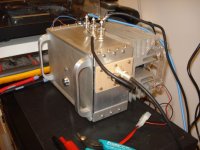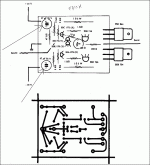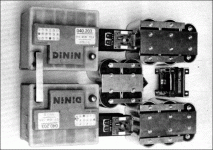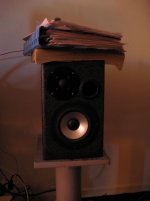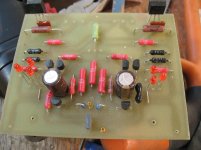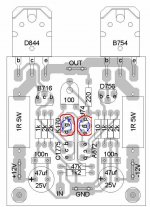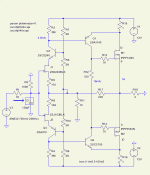gaborbela - off course that you right about bias/temp equilibrium ;
more or less - that's the case with all amps , especially with a class , and even more with simple A class amps
but - measuring with A-meter in-line or with V-meter across 1R resistor is absolutely same thing
it's even more convenient measuring across resistor , because it's easier to place two clips on it , then unsolder and later solder wire from PSU
more or less - that's the case with all amps , especially with a class , and even more with simple A class amps
but - measuring with A-meter in-line or with V-meter across 1R resistor is absolutely same thing
it's even more convenient measuring across resistor , because it's easier to place two clips on it , then unsolder and later solder wire from PSU
Yes you right if you know the voltage drop on the 1R 5W resistor!
Unfortunately all I know 08A total bias.
At first you set up the bias with A meter after you know the total bias when the amp is cold , when it warms up and you can measure the V across the 1R resistor and you will know always your bias after you measure the V drop on the 1R resister.
The problem people use different rail voltage . In that case these is the best way to know your bias.
Some people use 18V some 12V. It would be difficult to me to write how much V drop you have to get on the 1R resister .
But you also right in case if the rail voltage 12V.
Greetings
Unfortunately all I know 08A total bias.
At first you set up the bias with A meter after you know the total bias when the amp is cold , when it warms up and you can measure the V across the 1R resistor and you will know always your bias after you measure the V drop on the 1R resister.
The problem people use different rail voltage . In that case these is the best way to know your bias.
Some people use 18V some 12V. It would be difficult to me to write how much V drop you have to get on the 1R resister .
But you also right in case if the rail voltage 12V.
Greetings
Some suggest setting the bias between 0.5 and 0.6A. I guess this is what needed for class-A operation? The original hiraga sets the bias to a much higher level. With 1K resistors it sets to about >2A for my amplifier. I believe this is too much and the 1Ohm resistors get VERY hot. So why setting the bias as so high levels when you can achieve class-A operation at a much lower bias?
Anyway I have just set the bias on my le monstre at 0.55A so here are my first impressions from the amplifier.
My system:
le monstre amplifier
Preamplifier none
Source mini disc deck and output taken directly from the analog out. I use the digital attenuator of the mini disc.
power supply two 80AH deep cycle batteries. No PSU.
url of the construction Le monstre (please ignore the I/O connectors part as I have to review this)
Speaker cones audio nirvana super 8 full range
The amplifier impressions and technical observations:
I run the amplifier on a huge heatsink. It takes about 1hour to get half the heat and about 2hours to get at a quite high temperature.
At the beginning I had not used a fan for it and just waited for the amplifier to warm up after 2h in order to set the bias and the balance. The bias changes much when the amplifier is heated, about 100mV and maybe more.
I found it no practical to have to wait for 2h in order the bias to be automatically set to the correct value, so I thought to keep the temperature low at all times. So I added a big diameter 12V fan out of a computer heatsink and run the fan only on 5V. This eliminates any audible noise from the fan. After all just a low air flow is needed to keep the amplifier cool with so big heatsink.
*** I have a question here, is it ok to keep the amplifier cool at all times (thermal equilibrium issues between final transistors?)
Continuing my revision, by adding the fan in this slow-mode I found the heatsink temperature variations very small, near room temperature.After a long hour the bias remained quite constant and did not need to be reset. Also the parts inside the box (that touches the heatsink) remained cool now. If it is ok to run the amplifier cool, I think the problem of big bias change due to temperature variation has been solved... After all I found that the bias remains quite stable at voltage variations 13v-12v as the battery discharges. It seems to me bias is truly affected only by variations in temperature.
It has been 5 hours now of continuous operation of the amplifier with the 80AH batteries only, and they have been discharged from 13.5v to 12.4v after 5 hours. The manufacturer suggests not to discharge them below 12v for life extendability, so I guess with two 80AH batteries one can get at least 6 hours of continuous operation, which is not bad at all to my taste...
The sound:
The highs, Killing! Bright and distinct. I can listen up to 16KHz and that is my ear listening limit as far as I have noticed
The mids, bright and clear. female voices are separated well and distinct within the song.
The low end, a bit shy to my taste, but very controlled. The low frequency response is just too low for my ears to hear, I can see the speaker cone moving too much on 20Hz but I cannot hear the sound (maybe I have not golden ears ). A note here, my cabinets are very small and you cannot expect so full bass from a fullrange cone. Nevertheless I will have a more clean review about bass when I construct my BIB cabinets at a future time
). A note here, my cabinets are very small and you cannot expect so full bass from a fullrange cone. Nevertheless I will have a more clean review about bass when I construct my BIB cabinets at a future time 
And here is the photo of the amplifier in test mode operation
Anyway I have just set the bias on my le monstre at 0.55A so here are my first impressions from the amplifier.
My system:
le monstre amplifier
Preamplifier none
Source mini disc deck and output taken directly from the analog out. I use the digital attenuator of the mini disc.
power supply two 80AH deep cycle batteries. No PSU.
url of the construction Le monstre (please ignore the I/O connectors part as I have to review this)
Speaker cones audio nirvana super 8 full range
The amplifier impressions and technical observations:
I run the amplifier on a huge heatsink. It takes about 1hour to get half the heat and about 2hours to get at a quite high temperature.
At the beginning I had not used a fan for it and just waited for the amplifier to warm up after 2h in order to set the bias and the balance. The bias changes much when the amplifier is heated, about 100mV and maybe more.
I found it no practical to have to wait for 2h in order the bias to be automatically set to the correct value, so I thought to keep the temperature low at all times. So I added a big diameter 12V fan out of a computer heatsink and run the fan only on 5V. This eliminates any audible noise from the fan. After all just a low air flow is needed to keep the amplifier cool with so big heatsink.
*** I have a question here, is it ok to keep the amplifier cool at all times (thermal equilibrium issues between final transistors?)
Continuing my revision, by adding the fan in this slow-mode I found the heatsink temperature variations very small, near room temperature.After a long hour the bias remained quite constant and did not need to be reset. Also the parts inside the box (that touches the heatsink) remained cool now. If it is ok to run the amplifier cool, I think the problem of big bias change due to temperature variation has been solved... After all I found that the bias remains quite stable at voltage variations 13v-12v as the battery discharges. It seems to me bias is truly affected only by variations in temperature.
It has been 5 hours now of continuous operation of the amplifier with the 80AH batteries only, and they have been discharged from 13.5v to 12.4v after 5 hours. The manufacturer suggests not to discharge them below 12v for life extendability, so I guess with two 80AH batteries one can get at least 6 hours of continuous operation, which is not bad at all to my taste...
The sound:
The highs, Killing! Bright and distinct. I can listen up to 16KHz and that is my ear listening limit as far as I have noticed
The mids, bright and clear. female voices are separated well and distinct within the song.
The low end, a bit shy to my taste, but very controlled. The low frequency response is just too low for my ears to hear, I can see the speaker cone moving too much on 20Hz but I cannot hear the sound (maybe I have not golden ears
And here is the photo of the amplifier in test mode operation
Attachments
Hi neazoi,
Congratulations on the amp - looks good! The heatsink looks huge - I'm surprised you need the fans with such a big heatsink.
Actually, the original Hiraga article about the Le Monstre recommends a bias around 0.5A to 0.6A. (Although of course there is no law that you can't change it...) You can find the whole text at
The Class-A Amplifier Site - Jean Hiraga Index
although not all is translated into English.
Cheers, and congrats.
Nigel
Congratulations on the amp - looks good! The heatsink looks huge - I'm surprised you need the fans with such a big heatsink.
Some suggest setting the bias between 0.5 and 0.6A. I guess this is what needed for class-A operation? The original hiraga sets the bias to a much higher level.
Actually, the original Hiraga article about the Le Monstre recommends a bias around 0.5A to 0.6A. (Although of course there is no law that you can't change it...) You can find the whole text at
The Class-A Amplifier Site - Jean Hiraga Index
although not all is translated into English.
Cheers, and congrats.
Nigel
Hello
Nice amp , congrat..
There are some important info translated to English.
These info from the Le Monstre site.
The Class-A Amplifier Site - Hiraga 'The Monster'
One should not lose sight of the fact that the 8W functions in class A. The quiescent current therefore has a prime importance. Its value should not be too low otherwise the amplifier will pass into class AB on strong signals, nor too high because it would impose too great a dis*sipation on the power transistors which, in addition to the fact of limiting their lifespan, can lead to thermal runaway. Indeed, the characteristics of the power transistors are related to the temperature of the junctions and beyond a certain threshold there is runaway, that is to say the more the temperature rises the more the current increases. The optimal value lies between 0.5 and 0.6A.
To measure the quiescent current, it is sufficient to measure the voltage across the 1 ohm 5W resistors. The voltage must therefore be between 500mV and 600mV. After sorting the batches of transistors, 2SD844/2SB754 on the one hand and 2SB716/2SD756 on the other, one can be placed in non-optimal operating conditions from the point of view of quiescent current. The remedy is extremely simple. If the quiescent current is too high, it is enough to decrease the bias resistors of 2SB716 and 2SD756 transistors, whose initial value is 1 kohm. These resistors coming from the bases of the transistors determine their point of operation and consequently the collector current, on which depends the quiescent current. In general, it is enough to change from 1 kohm to 910 ohm for the quiescent current to take the correct value again.
My opinion if the amp run a bit hot sound better.
These you do not hear right away when you first time you power up your amp.
There is a brake in time for the component , wires etc.
With that heat sink you do not need any fan.
The bias depend a lot what grade JFet you use..
The original Le Monstre was built with Y grade JFet.
If you use different grade , GR , BL you have to adjust the 1K resistor so the amp run all the 8W in Class A.
I read somewhere the proper bias 08A for the Le Monstre.
Here it say you measure 500-600mV drop on the 1R resister.
Do you use any PS capacitors??
Than can influence the bass of the amp!
If you look the orig Le Monstre it use capacitors not just battery. Also you have to use the 2 piece 47uF capacitors on the PC board.
If you can get some Elna Silmic that has good bass..
Also make sure the wires from the battery to the amp to be thick enough..
How N Pass advised as short as possible and as thick as possible.
If your wire to thin your amp will suffer..
I sold over 100 set Le Monstre transistors, nobody wrote me back the amp has shy bass.
Also I built one with Capacitance Multiplier PS. The amp sounded well balanced..
Now I want to try the mosfet verison..
Greetings
Nice amp , congrat..

There are some important info translated to English.
These info from the Le Monstre site.
The Class-A Amplifier Site - Hiraga 'The Monster'
One should not lose sight of the fact that the 8W functions in class A. The quiescent current therefore has a prime importance. Its value should not be too low otherwise the amplifier will pass into class AB on strong signals, nor too high because it would impose too great a dis*sipation on the power transistors which, in addition to the fact of limiting their lifespan, can lead to thermal runaway. Indeed, the characteristics of the power transistors are related to the temperature of the junctions and beyond a certain threshold there is runaway, that is to say the more the temperature rises the more the current increases. The optimal value lies between 0.5 and 0.6A.
To measure the quiescent current, it is sufficient to measure the voltage across the 1 ohm 5W resistors. The voltage must therefore be between 500mV and 600mV. After sorting the batches of transistors, 2SD844/2SB754 on the one hand and 2SB716/2SD756 on the other, one can be placed in non-optimal operating conditions from the point of view of quiescent current. The remedy is extremely simple. If the quiescent current is too high, it is enough to decrease the bias resistors of 2SB716 and 2SD756 transistors, whose initial value is 1 kohm. These resistors coming from the bases of the transistors determine their point of operation and consequently the collector current, on which depends the quiescent current. In general, it is enough to change from 1 kohm to 910 ohm for the quiescent current to take the correct value again.
My opinion if the amp run a bit hot sound better.
These you do not hear right away when you first time you power up your amp.
There is a brake in time for the component , wires etc.
With that heat sink you do not need any fan.
The bias depend a lot what grade JFet you use..
The original Le Monstre was built with Y grade JFet.
If you use different grade , GR , BL you have to adjust the 1K resistor so the amp run all the 8W in Class A.
I read somewhere the proper bias 08A for the Le Monstre.
Here it say you measure 500-600mV drop on the 1R resister.
Do you use any PS capacitors??
Than can influence the bass of the amp!
If you look the orig Le Monstre it use capacitors not just battery. Also you have to use the 2 piece 47uF capacitors on the PC board.
If you can get some Elna Silmic that has good bass..
Also make sure the wires from the battery to the amp to be thick enough..
How N Pass advised as short as possible and as thick as possible.
If your wire to thin your amp will suffer..
I sold over 100 set Le Monstre transistors, nobody wrote me back the amp has shy bass.
Also I built one with Capacitance Multiplier PS. The amp sounded well balanced..
Now I want to try the mosfet verison..
Greetings
Attachments
Hello
Do you use any PS capacitors??
Than can influence the bass of the amp!
If you look the orig Le Monstre it use capacitors not just battery. Also you have to use the 2 piece 47uF capacitors on the PC board.
If you can get some Elna Silmic that has good bass..
Also make sure the wires from the battery to the amp to be thick enough..
How N Pass advised as short as possible and as thick as possible.
If your wire to thin your amp will suffer..
I sold over 100 set Le Monstre transistors, nobody wrote me back the amp has shy bass.
Also I built one with Capacitance Multiplier PS. The amp sounded well balanced..
Now I want to try the mosfet verison..
Greetings
Yes apart from the batteries, I use 6600uF elna cerafine electrolytics paralel with 0.47uF teflon capacitor in each channel.
I believe the PSU wires are well suited for 1A per channel, they are about 1mm diameter, and the GND one is about 2mm. I have used BNC for power which have a 1mm internal conductor diameter after all.
Now do not take me wrong, The bass is ok, but I just would prefer a bit more of it. But have in mind that the super 8 cones have 102dB sensitivity on highs and about 90dB sensitivity on low end. The cabinets are very small for these speakers, about the size of a computer box. I think when I build the bib cabinets, which are about 2m tall this will physically amplify the bass up to the desired level.
This big heatsink comes to about 30-35C degrees after about an hour and about 50-60C degrees after 2h. The reason I use the fan operating in slow mode, is not to cool it down, but just to keep the temperature stable (i.e always cooled) so that there is no temperature variation that could alter the bias (and balance) of the amplifier.
Hiraga constructed each channel of the amplifier in a separate smaller heatsink and the box was full of little holes (If I remember well) so the components did not heat too much when the heatsink heated. I bet the amplifiers would need some kind of fan to cool down the much smaller heatsink though.. In my version I used one box for all circuicity and no holes on it so all the components inside the box are affected by the changing temperature of the touching heatsink and this affects both bias and balance. That is why I have chosen to keep the temperature of the heatsink low, down to room temperature, using this fan.
All I need to know is, if it is good to keep temperature to room level or if it "needs" to be actually heated, as I am not too good on thermal (stability?) issues on class-A?
Member
Joined 2009
Paid Member
I can't think of a good reason why you'd want it to be hotter than room temperature since it extends the life of all the components when you keep them cooler. Also, since transistor operating parameters are temperature sensitive it helps to keep them at one temperature.
There are some people who feel that running transistors hot is good because the influence of large signal induced junction temperature fluctuations will then be a relatively small influence.
With a fan I'd be wanting to ensure that there was no chance of electrical noise from the fan motor getting into the audio and I'd want to know that if the fan failed the amp wouldn't blow up. Other thing about fans, eventually there is a nasty build up of dust somewhere - just look at an old computer switch mode power supply module.
There are some people who feel that running transistors hot is good because the influence of large signal induced junction temperature fluctuations will then be a relatively small influence.
With a fan I'd be wanting to ensure that there was no chance of electrical noise from the fan motor getting into the audio and I'd want to know that if the fan failed the amp wouldn't blow up. Other thing about fans, eventually there is a nasty build up of dust somewhere - just look at an old computer switch mode power supply module.
Yes apart from the batteries, I use 6600uF elna cerafine electrolytics paralel with 0.47uF teflon capacitor in each channel.
I believe the PSU wires are well suited for 1A per channel, they are about 1mm diameter, and the GND one is about 2mm. I have used BNC for power which have a 1mm internal conductor diameter after all.
Now do not take me wrong, The bass is OK, but I just would prefer a bit more of it. But have in mind that the super 8 cones have 102dB sensitivity on highs and about 90dB sensitivity on low end. The cabinets are very small for these speakers, about the size of a computer box. I think when I build the bib cabinets, which are about 2m tall this will physically amplify the bass up to the desired level.
Hello
I think you PS wire to thin! Usually the battery far from the amp bcoz they heavy etc , please if you have thicker wire try to hook up with that.
These not because those wires can't deliver 1A. Here you have to think about the to get the best sound, the best solution..
Different when you hook up a light bulb etc.
Usually the components can deliver better sound in a elevated temperature.
I do not want to argue on these .
Even factory made Class A/B amp sound better after warm up.
Right now I listen a Nackamichi , I know what I'm talking.
About these ask people like Mr N Pass who built Class A amps all his life..
I just have only 20 years experience..
On the forum someone started a post to build the best Aleph amp as possible.
Please look up that..
I do not write you run the amp 60C degree, no reason for that.Your speakers really small to get the correct evaluation..
All I can say the Le Monste has more than enough bass with the right speakers , speaker cable , music source etc.
Also next to the battery Hiraga use a lot of capacitor, I think that not in vain.
On the PC board do you use any electrolytic??
That is very important to. 47uF..
I post some picture so you can think about.
Greetings
Attachments
I can't think of a good reason why you'd want it to be hotter than room temperature since it extends the life of all the components when you keep them cooler. Also, since transistor operating parameters are temperature sensitive it helps to keep them at one temperature.
If you want to extend the life of the components well better just keep them in the shelf!
I think here you want to get the best sound as possible ..
To me that is the first purpose DIY... That is the reason to build Class A ..
Even factory made amp (Class A/B) like Nacamichi after 1 hour run much warmer than room temp. About 40-45C degree..
Greetings
Last edited:
Hello
These speakers I used with the Le Mosntre . The enclosure about 12L BR..
I use Visaton AL130 and Audax tweeters .
I was satisfied with the Le Monstre , and my speaker only 87db.
I had more than enough bass , with the P Daniel Gain clone the bass was a bit shy.
Right now mostly I build my amp using power mosfets..
But also I want to give a try the Hiraga Class A one more time , to me that has more balanced sound.
Has more tube like sound..
These is a new type of PC board , not finished yet. Power transistors etc need to be mounted.
Greetings
These speakers I used with the Le Mosntre . The enclosure about 12L BR..
I use Visaton AL130 and Audax tweeters .
I was satisfied with the Le Monstre , and my speaker only 87db.
I had more than enough bass , with the P Daniel Gain clone the bass was a bit shy.
Right now mostly I build my amp using power mosfets..
But also I want to give a try the Hiraga Class A one more time , to me that has more balanced sound.
Has more tube like sound..
These is a new type of PC board , not finished yet. Power transistors etc need to be mounted.
Greetings
Attachments
Hi bobodioulasso from South-West Forest (les Landes ?) !
I'ld know your interest for Le Monstre and remplacement devices you suggest.
Cordialement
Michel from South-Est (Pyrénées-Orientales)
I have not built any monster for now, only some F5, but will certainly build one some day to compare.
I live 50km from Agen.
Hi Garborbela,
Would you post the schematic for your Monster version?
You use LED for and Z-Diodes for stabilizing the working points?
Regards
SAm
I'm curious too.
Thanks in advance
PYJ
Hi, I have started the construction of the Le monstre amp with new parts.
I tested this amplifier in Spice. I think that the THD is too high - 0.5% @ 1V input , 1Khz and output about 6.5 volts. With BC 550/560 as drivers - even worse.
Bias 0.6 A gains 16.6db.
I saw better results in your sims. Its maybe transistor model problems or just fine for Le monstre ? (just want to know before I started to solder )
)
regards,
Oskars

I tested this amplifier in Spice. I think that the THD is too high - 0.5% @ 1V input , 1Khz and output about 6.5 volts. With BC 550/560 as drivers - even worse.
Bias 0.6 A gains 16.6db.
I saw better results in your sims. Its maybe transistor model problems or just fine for Le monstre ? (just want to know before I started to solder
regards,
Oskars

Hello Osscar
Can you do a favour to me, please.
I want to build the mosfet version of the Hiraga le Monsstre.
Can you run a sim. on these schematic.
With only one change I'll use Toshiba power mosfet.
2SK1529 & 2SJ200 or I have the bigger brother 2SK1530 & 2SJ201.
I'm planing to increase the PS to 17VDC.
Of course with max 1A total bias. I'll take care of that!
I just ordered the resistors for these amp. Only I have to get some driver..
I would not use the BD drivers! Take a look the modified version at Kristijan website! I'll look up for you that schematic, and I'll post it.
Thank you very much
Greetings
gabor
Can you do a favour to me, please.
I want to build the mosfet version of the Hiraga le Monsstre.
Can you run a sim. on these schematic.
With only one change I'll use Toshiba power mosfet.
2SK1529 & 2SJ200 or I have the bigger brother 2SK1530 & 2SJ201.
I'm planing to increase the PS to 17VDC.
Of course with max 1A total bias. I'll take care of that!
I just ordered the resistors for these amp. Only I have to get some driver..
I would not use the BD drivers! Take a look the modified version at Kristijan website! I'll look up for you that schematic, and I'll post it.
Thank you very much
Greetings
gabor
Attachments
- Home
- Amplifiers
- Solid State
- Hiraga "Le Monstre"
